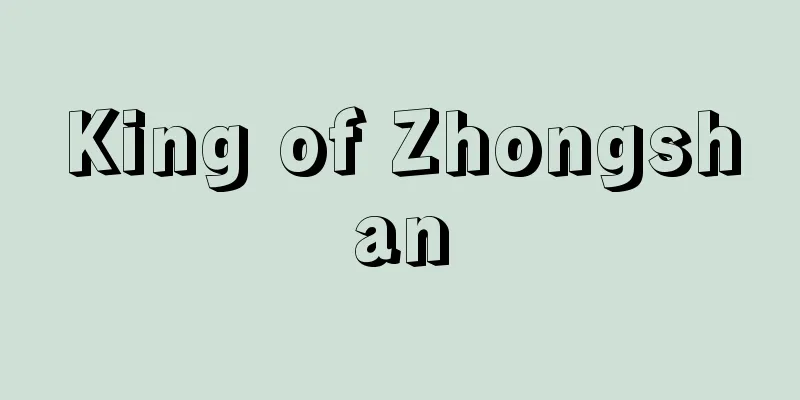Anzu - Business

|
An accessory to horse harness or armor. It is thought to have been named for its resemblance to an apricot leaf in shape. The apricot leaves on horse harness are ornaments attached to the saddles of the Kofun period and later Karakura saddles. Intricate gilt bronze openwork carvings have been excavated from Late Kofun Tombs and the Munakata Taisha Okinoshima Ritual Site. The apricot leaves attached to armor are shoulder protection attached to the upper shoulders of the domaru (a style of right-drawing combination that was called a belly warmer at the time) worn by subordinate soldiers who fought standing on their feet in the Middle Ages. It is a palm-sized iron plate with a unique shape and slight bulge, and generally has a folded top, painted leather on the surface, metal fittings for the mounting, a border around the perimeter, and a hole at the top for a string. After the Northern and Southern Court period, when domaru came to be worn by samurai on horseback and had large sleeves, its use changed and it became an accessory that hung down in front of the chest and covered the takahimo (high-stripe cord), gradually becoming more formal and smaller. Apricot leaf relics include a Kagamiji (mirror-ground) apricot leaf with a crane and pine needle design believed to have been made in the Kamakura period that has been handed down to Tsurugane Shrine in Kagoshima City, and many other apricot leaves are attached to domaru from the Northern and Southern Courts and Muromachi periods. Additionally, an old-fashioned apricot leaf with a Kagamiji pattern has been excavated from Hokkaido. In the Edo period, as armor styles became more diverse and more dignified, it was used not only for domaru but also for revival-style belly wraps and modern armor, causing the shape to change. [Motoo Yamagishi] Source: Shogakukan Encyclopedia Nipponica About Encyclopedia Nipponica Information | Legend |
|
馬具もしくは甲冑(かっちゅう)の付属具。形状が杏(あんず)の葉に似るとして命名されたものと考えられる。馬具の杏葉は、古墳時代の鞍(くら)や後の唐鞍(からくら)の鞦(しりがい)につけた装飾具である。後期古墳や宗像(むなかた)大社沖ノ島祭祀(さいし)遺跡などから金銅透(こんどうすかし)彫りの精巧なものが出土している。甲冑付属の杏葉は、中世に徒立(かちだち)で戦った下卒が着た胴丸(どうまる)(右引合せ形式で当時は腹巻と呼称された)の肩上(わたがみ)に結び付けた肩先の防具である。軽い膨らみをもった独特の形の掌(てのひら)大の鉄板で、一般に上部を折り返し、表面に絵韋(えがわ)を張り、据文(すえもん)金物を打ち、周囲に覆輪をかけ、上部の穴に緒の設けがある。 南北朝時代以降、胴丸が騎馬の武士に着用され、大袖(おおそで)がつくようになると、用途を変じ、胸前に垂下して高紐(たかひも)を覆う装具となり、しだいに形式化して小さくなった。杏葉の遺物は、鹿児島市鶴ヶ嶺(つるがね)神社に鎌倉時代の作と推定される鏡地(かがみじ)鶴松葉文の杏葉が伝来するほか、南北朝・室町時代の胴丸に多く付属している。また、北海道から鏡地の古風な杏葉の出土がある。江戸時代には甲冑形式の多様化と威儀化から、胴丸のほか復古調の腹巻・当世具足などにも用いられて形状を崩した。 [山岸素夫] 出典 小学館 日本大百科全書(ニッポニカ)日本大百科全書(ニッポニカ)について 情報 | 凡例 |
<<: Bildungsroman (German: Bildungsroman)
Recommend
Shikotansou - Shikotansou
A perennial plant of the Saxifragaceae family (AP...
Red colobus
A species of primate in the Cercopithecidae family...
Iwanami Bunko - Iwanami Bunko
A small (A6 size) inexpensive paperback first publ...
Quota - Quota
A share. A share. An allotment. 2 ⇒ Disk quota Sou...
Toleration Act
This law was enacted in England in May 1689, imme...
Özbeg-Qazaq (English spelling)
At that time, under pressure from the Uzbek Abu a...
Kilner, WJ
...In the scientific field, it has been studied i...
Luo Changpei - Rajoubai
Chinese linguist. Born in Beijing. Professor at Pe...
Exbury Azalea
...In Japan, there is Rhododendron japonicum Suri...
Souzey, Gérard
Born December 8, 1918 in Angers. A French baritone...
Hydroazoic acid - Ajikasuisosan
...It is highly soluble in water and ethyl alcoho...
Armidale - Armidale (English spelling)
A city in the northeast of New South Wales, Austr...
Sache
…Koto is a distinctively Japanese concept of exis...
dumb cane
…The genus Dieffenbachia (Dieffenbachia) of the A...
Uonuma Line - Uonuma
...A city located almost in the center of Niigata...









